 |
||
|
||
| ||
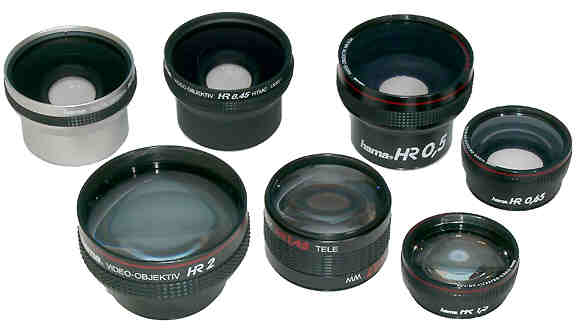 Upper row, left to right: HR 0.5 (44331), HR 0.45 (44341), HR 0.5 (44380), HR 0.65 (44384) Lower row: HR 2 (44382), HR 0.7/1.45 (44371), HR 1.5 (44384) Afocal (telephoto) converters, like opera glasses, are needed if you've got bad tickets for performance. It's in fact a Galilean telescope (opera glass): if a front lens is positive and a back one is negative, the converter will increase the lens focal length, otherwise it will be a wide-angle one. This time I have 7 converter. One of them, 44371, is universal (it can be as telephoto, and then it increases the focal length 1.45 times, or wideangle, in this case it reduces the length 0.7 times; its function depends on how you attach it), and the rest are usual, which means that you can attach them one way only. Of course, you can try to connect them differently, but I'm afraid the results won't be acceptable at all. The cheapest converter consist of two lenses (44384), the dearer ones
are made more sophisticated to eliminate chromatic aberrations.
So, we tested 5 wideangle converter: 0.5 models 44380, 44331, 0.45 model 44341, universal 44371 0.7, a wideangle converter from 44384 series 0.65 and 3 telephoto converters: 2x 44382, 1.5 44384, and universal 44371. The tests were carried out with Casio QV 4000 camera equipped with the most popular 3x lens, 7 to 21 mm. Similar results could be obtained with Canon (G1,G2), Casio (QV3000,QV3500,QV4000), Epson PC 3000Z, Toshiba PDR-M70, and Sony (S70,S75,S85) cameras. Also, we used a more exotic SUPER lens - EBC FUJINON sporting 6x zoom (7.8-45mm). Mounts and how they attach to camerasThe converters are mounted on color filter threads; their thread makes 58, 52 and 49 mm. Thankfully, Hama bundled their products with a good set of adapter rings. All of the converters can be attached to 46, 49, 52mm threads with the rings bundled, and some even to 43, 55, 58mm threads. 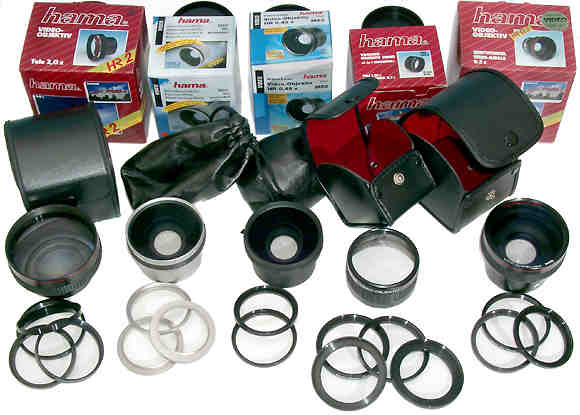 Unfortunately, we can do nothing with manufacturers of cameras with a 47.5mm thread. Another problem is that most digital cameras have threads on the camera's body instead of the lens, and an adapter ring should compensate for lens' moving out from the transportation position into the working one. That is why you can't avoid mounting the converter through a system of rings. Casio QV4000 camera, LU-35A ring of 47.5-58mm thread, 58-49 stepdown ring, and then, if a converter has a 52mm thread, goes a 49-52 ring. The converter must be as close to the front lens as possible to avoid vignetting. Only 2x telephoto converter 44382 has a logical design when a comprensating ring 52-52 is used. If you need another thread, you must replace it with an adapter ring of a required thread. In this case all threads are in the equal position.  FUJIFILM FinePix 6900 camera has a standard thread of 55 mm but converter can't be directly mounted because the lens must be able to move out by 4 cm from the transportation position. I didn't have special ring and solved the problem by using several color filter mounts of 55mm thread. Such design can easily make up for additional adapter rings even if the mount is not meant to do it. It's quite a matter of taste whether colors of converter and cameras match. French people say that pour etre joli il faut souffrir (to be beautiful one has to suffer), but it's not for me to suffer a poor image. A silvery body of the wideangle converter 44331 is very beautiful but the most part of its inner surface is also coated with silver. This silvery ring which can be seen even through the front lens brought to nothing all developers' attempts to blacken the inner surface. Taking into account that light can easily get onto shots through wideangle converter and blends can hardly help it, this product below is a kind of labor of Sisyphus.  Test resultsFirst off, let's discuss converters' factors and what focal length should be chosen when a camera is used with converter. For telephoto ones makers of cameras and converters recommend to use it with the lens fixed for the maximum focal length. But wideangle converter are not so easy in use. A wide angle can be obtained at the minimal focal length but it will entail noticeable vignetting and edge aberrations. By increasing the focal length we can reduce these problems, but expansion of the working range of the camera's focal length won't be so impressive though the converter's factor doesn't change. Testing the converters 0.5 and 0.45 I obtained the acceptable results at the lens focal length starting from 10 mm. Thus, the minimal focal length got reduced 0.7 times. With Casio QV 4000 camera we shot radial and circular resolutions charts printed on the matt film Epson S041071 attached on Hama light table of 8000 K color temperature. The stripes differed over 50 times in brightness. White balance was manually adjusted. The camera was focused with the resolution charts in the frame center, then the camera was turned so that the chart would get into the corner. The shots were made at the aperture of f:8. Take a look at the shots of the chart made with the camera without any converter. Shots of the chart placed in the center made with the camera with and without converter are almost identical; that is why I will sift the shots only with the chart located in the corner. The radius in pixels outside of which all grooves are discernible is marked R. In case of astigmatism the circle turns into ellipse, and we measure semiaxes in the meridional (Rm) and sagittal (Rs) planes. As you can see, focusing rays coming in the meridional section turn a focusing circle into a line which lies in the sagittal plane, and vice versa, focusing rays in the sagittal section turn a a focusing circle into a line lying in the meridional plane. Groove-per-pixel resolution can be calculated with the following formula: 180/6.28R. Black and white lines make two grooves. HR2 (44382)
Compare it with a similar image obtained with the 2.3x telephoto converter
composed of Gelios-44 and Ortagoz 135 lenses:
Well, I have no comments here.
HR 1.45 (44371) Coordinates of the resolution chart center relative to the upper left-hand corner: X=218, Y=221, aperture f:8, Lens focal length: f=20.7. Coordinates of the radial resolution chart center: Xr=582, Yr=239, RS=53, Rm=43. HR 1.5 (44384)X=159, Y=219, f:8, f=20.7mm. Xr=511, Yr=234, RS=52, Rm=43. HR 0.45 (44341)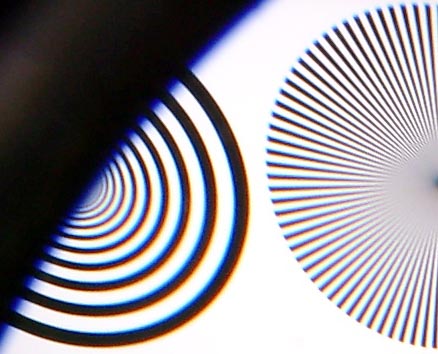 f:8, Lens focal length: f=7.1mm. Focal length of the optical system made of camera lens and converter - Fs= 3.2 mm. Radial resolution chart center: Xr=588, Yr=213, RS=57. Rm=43. Noticeable vignetting and chromatic aberrations. The lens focal length increased up to 11.8 mm.  X=186, Y=281, f:8, f=11.8mm, Fs= 5.3 mm, The picture is much more pleasant now, but the factor which defines expansion of focal length range (focal length of the system composed of lens and converter to the minimal focal length of the camera lens) is N=0.74. Photo of
the radial resolution chart
At the focal length of 10.4 mm the picture looks also acceptable but there are considerable aberrations. in the corner. 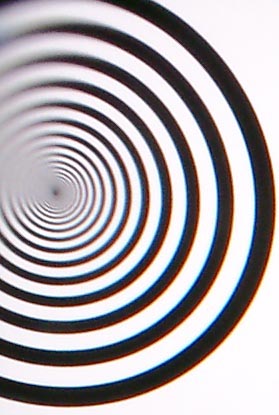 X=55, Y=192, f:8, f=10.4mm, Fs= 4.68mm, N=0.66. Take a look at the image made with this converter and FUJIFILM FinePix 6900 camera (2832 x 2128). 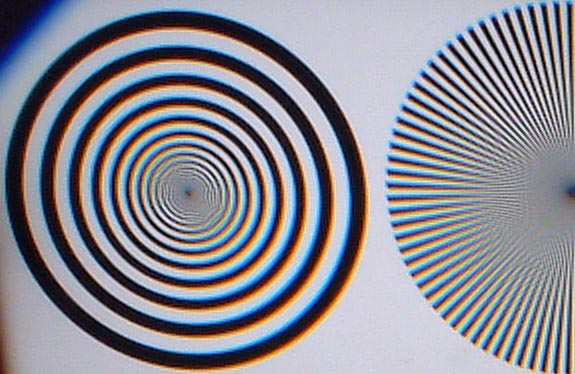 Xr=875, Yr=325, RS=96, Rm=64. For comparison with cameras based on standard CCD matrix let's multiply the figures by 0.71 - correlation of linear dimensions of the shot with the equal number of sensors of cameras equipped with SUPER CCD and CCD matrices. R's=68, R'm=45 X=490, Y=326, f:8, f=7.8 mm, Fs= 3.5 mm. I paid so much attention to the results obtained with this converter because I guess this one is the most attractive. HR 0.5 (44380)f:8, f=7,1 mm. Fs=3,55, Xr=582, Yr=228, RS=58, Rm=43. Photo of the resolution chart X=230, Y=316, f:8, f=10,4mm, Fs= 5,2mm,N=0,73. Xr=725, Yr=319, RS=49, Rm=46. HR 0.5 (44331)f:8, f=7.1 mm. Fs=3.55, Xr=585, Yr=205, RS=57, Rm=43. Photo of the resolution chart X=230, Y=316, f:8, f=10.4mm, Fs= 5.2mm,N=0.73. Xr=705, Yr=289, RS=49, Rm=46. HR 0.65 (44384)f:8, f=7.1 mm. Fs=4.63, Xr=636, Yr=264, RS=50, Rm=44. Photo of the resolution chart X=248, Y=259, f:8, f=8.4 mm, Fs= 5.46 mm, N=0,77. Xr=705, Yr=289, RS=48, Rm=43. HR 0.7 (44371)f:8, f=7.1 mm.Fs=4.99, Xr=491, Yr=212, RS=61, Rm=43. Photo of the resolution chart X=183, Y=229, f:8, f=8.4mm, Fs= 5.88mm, N=0.82. Xr=642, Yr=217, RS=56, Rm=43. To demonstrate chromatic aberrations. we used Levels program of Dmitry Kuznetsov to draw diagram of signal amplitude vs. distance along the line crossing the circular resolution chart from the frame center. The figures above mark the distance from the chart center in pixels. The figures in the center of each diagram show the distance between the circular chart center and frame center in pixels and percentage-wise. Center - 0%, frame corner - 100%. The zone being 74-76% away from the frame center is marked gray to make it easier to choose the parts for comparison, because it's logical to compare chromatic aberrations. at equal distances from the center. The data for FUJIFILM FinePix 6900 camera which has a large frame of 2832 x 2128 pixels, are marked red. The other diagrams correspond to shots of the charts made with Casio QV-4000, 2240 x 1680. Click the diagrams with right button to enlarge. Summary table of the parameters measured.
Example of using a wideangle converterMiniatures of the upper part of the shot. 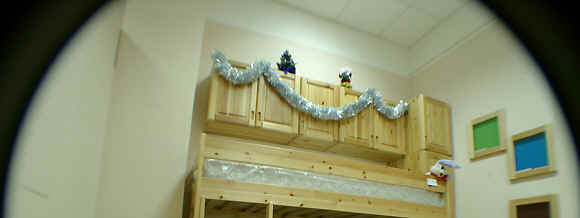
HR 0.45 (44341). Focal length of the lens of Casio QV4000 f=7.1 mm. Focal length of the optical system made of camera lens and converter - Fs= 3.2 mm. 
HR 0.45 (44341). f=9.8 mm. Fs= 4.4 mm. 
Casio QV4000 without converters. f=7.1 mm ConclusionPerformance of the telephoto converters is rather poor, they are inferior even to a plain Kepler telescope made of two photo lenses. More or less good results are achieved with the converters of the factor up to 1.5. As to wideangle converters, only 0.45 and 0.65 models have acceptable results; moreover, the lens focal length should be 0.7-0.8 relative to the minimal one for a given lens. The problem is not only vignetting, which is actually often acceptable for wideangle lenses because a shot is usually cut above and below and darkened corners remain out of shot, but noticeable aberrations. on edges. So, if Canon's converters make possible to change the minimal focal length 0.7 times, Hama's converters work with longer-focus lenses, expanding camera's capabilities to the same extent in spite of the same converter's factor. HR 0.45 (44341), HR 0.5 (44380), HR 0.5 (44331) converters have very close results, but HR 0.5 (44380) suffers a bit worse aberrations., and HR 0.5 (44331) comes with a glare-bringing body. HR 0.65 (44384) can be of interest only because of its price/quality ratio. The lenses with a more changeable focal length (over 3) have all their resources
exhausted, and further extension of the focal length range may cause quality degradation.
I made sure once again when I tried converters with the SUPER lens EBC FUJINON.
Write a comment below. No registration needed!
|
Platform · Video · Multimedia · Mobile · Other || About us & Privacy policy · Twitter · Facebook Copyright © Byrds Research & Publishing, Ltd., 1997–2011. All rights reserved. |